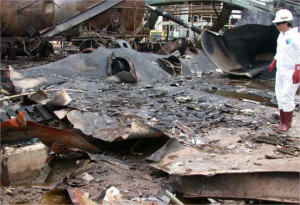A 90 m3-capacity railroad tank car containing about 25 m3 of hazardous waste, catastrophically ruptured at 9:30 a.m. at a transfer station of a chemical company. The tank car had been steam-heated to permit the transfer of the waste to a highway cargo tank for subsequent disposal. The waste consisted of 94 % cyclohexanone oxime, 4% water, and 2% cyclohexanone. The railway car was a jacketed, stainless steel, general-purpose tank car equipped with exterior heating coils; it had glass wool and ceramic fibre blanket insulation covered by a steel jacket.
As a result of the accident, 28 people received minor injuries, and residents living within 1 mile of the accident site had to shelter in place for 5 1/2 hours. The tank car, highway cargo tank, and transfer station were destroyed. The force of the explosion propelled a 134 kg tank car dome housing about 500 m away. Two storage tanks near the transfer station were damaged (domino effect) releasing 2,5 m3 of oleum (fuming sulfuric acid and sulfur trioxide).
The US National Transportation Safety Board determined that the cause of the rupture of the railroad tank car was overpressurization resulting from a runaway exothermic decomposition reaction initiated by excessive heating of a hazardous waste material. Contributing to the accident was corporation’s failure to monitor the temperature and pressure inside the tank car during the heating of the hazardous waste.




